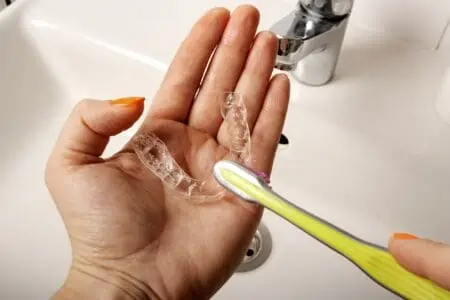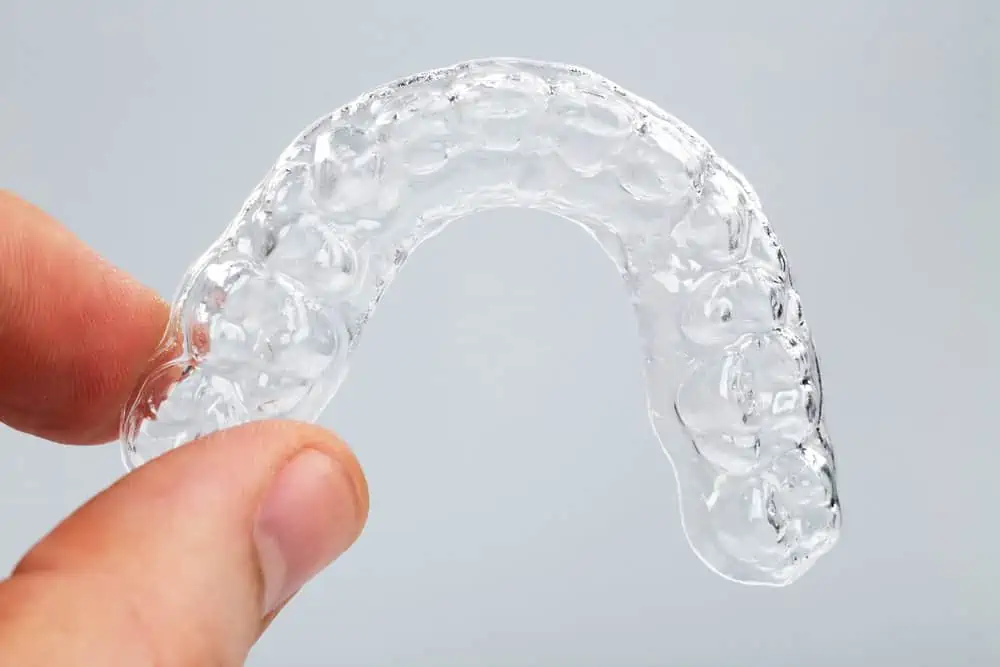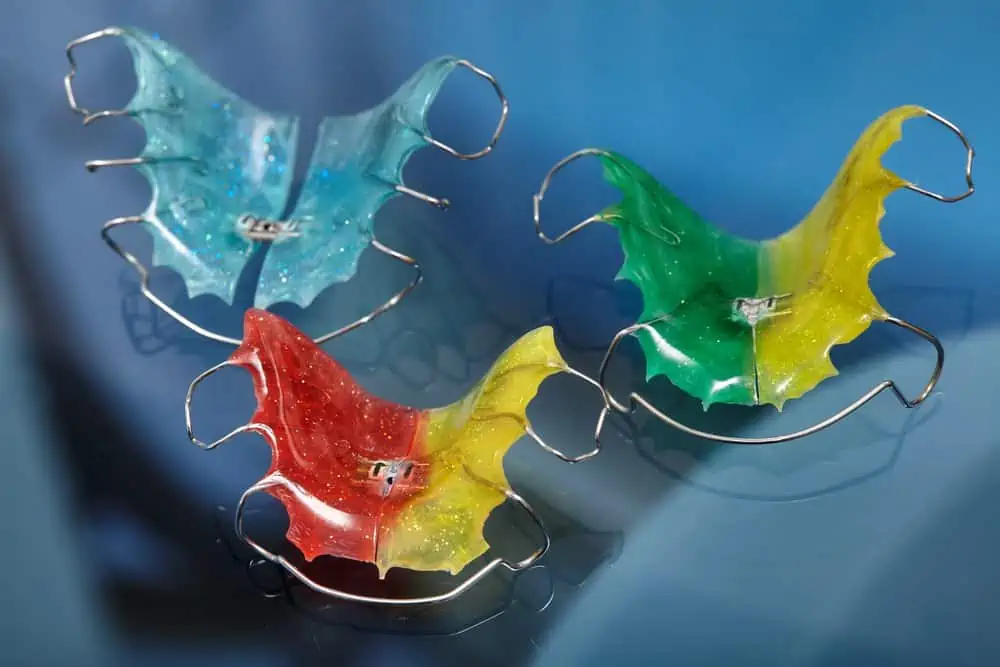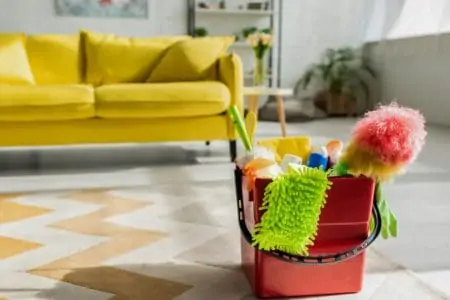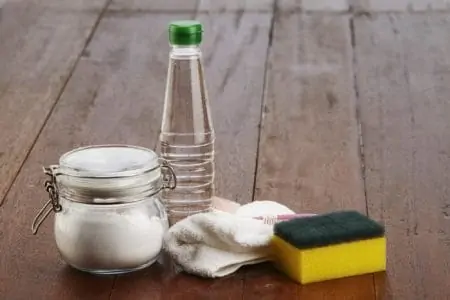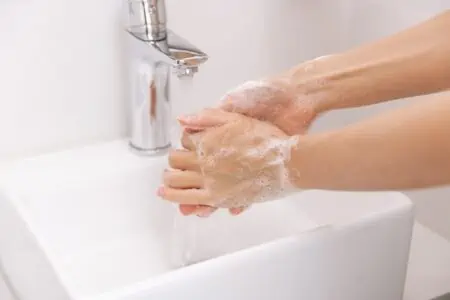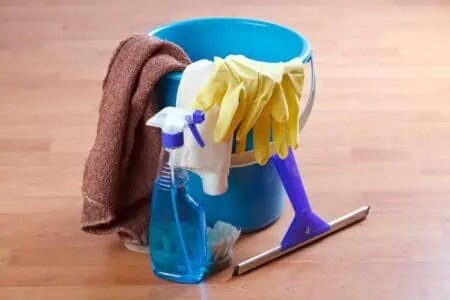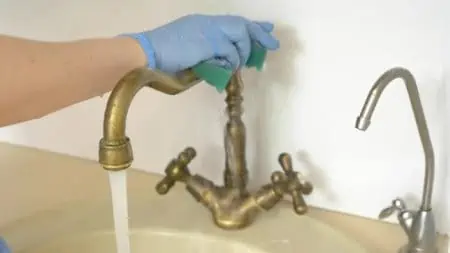An unclean retainer can taste awful when you put it in your mouth. It can harbor horrible stains, and even worse, mold and bacteria can start to multiply rapidly. That’s not the kind of thing you want against your teeth!
Mouth hygiene is super important, so it’s crucial to know how to clean a retainer properly. Thankfully we’ve used retainers for years, so we have fantastic methods for cleaning plastic retainers, wire, fixed, and more.
Keep reading for an easy-to-follow guide that will have your retainer spotless and germ-free.
Key Takeaways
- Clean your retainer daily, and perform a deep clean weekly to remove plaque and bacteria.
- Different types of retainers, such as plastic, wire, and fixed, require unique cleaning methods.
- Use a soft-bristled toothbrush, lukewarm water, and gentle cleaners for regular cleaning.
- Replace your retainer when it’s damaged, smells bad, or no longer fits properly.
How Often Should Retainers be Cleaned?
A quick daily clean is essential for staying on top of dirt and germs. We recommend issuing a deeper clean once a week to kill further bacteria and remove plaque.
On the topic of plaque, this white formation can build up on your retainers. It can dry and harden into the retainer, becoming challenging to remove. Over time, it can damage the retainer, which is costly to replace.
Types of Retainers
There are a few different types of retainers, and they all require a unique cleaning method.
Plastic
These clear retainers are made from plastic. While they’re easy to clean, they do show stains and plaque more easily. People like them because they are almost invisible and can help keep teeth in place.
On the other hand, they aren’t as durable. You might have to get a replacement every couple of years due to warping and stains.
Wire
A wire retainer, also known as a removable Hawley Wire, is often used to fix over and underbites. They are expensive to replace, so it’s important to care for and clean them.
When cleaning, you must remember to clean both the wire part and the hardened coverage. We will provide cleaning advice for both parts.
Fixed
A fixed or permanent retainer bonds to the back of your teeth. These usually last for years if properly installed and taken care of. You can brush and floss them, but it’s a little more challenging than cleaning your teeth.
How to Clean a Plastic Retainer
Let’s start with a plastic retainer. We’ve been using this kind for years. It’s important to clean it every day to avoid stains, build-up, and odors.
Remember that this works for both post-braces retainers or clear braces, like Invisalign or Essix.
- Time: Three minutes.
- Difficulty: Easy.
What You’ll Need
- Soft-bristled toothbrush.
- Jar with warm water.
- Dish soap (optional).
1. Rinse the Retainer
After removing the retainer, wash it immediately. You don’t want to take out your retainer and leave it on your bedside table. The plaque and saliva can harden, causing build-up over time.
Right away, rinse your retainer under lukewarm water to remove debris and dirt.
2. Brush
Use a soft-bristled toothbrush — separate from the one you use for your teeth — to gently brush out dirt and residue. Make sure the toothbrush is soft and gentle, so you don’t scratch the plastic.
3. Store the Retainer
Until you wear it next, store it in a jar with warm water. This will keep it moist and prevent elements from hardening to the plastic. Add a tiny drop of dish soap to the water if you want extra cleaning power.
Before you put the retainer back in, give it a good rinse to remove dish soap residue.
Top Tip
If your manufacturer advises against dish soap, use Castille soap instead. It’s less harsh.
How to Clean a Wire Retainer
You should clean your wire retainer after each use, too. This is the best method for doing so. The most significant difference between this and a plastic retainer is that you shouldn’t soak the wire retainer for long periods.
This is especially true if your wire retainer has a metal solder which can become damaged when submerged in water.
- Time: Three minutes.
- Difficulty: Easy.
What You’ll Need
- Lukewarm water.
- Soft-bristled toothbrush.
1. Rinse the Retainer
Rinse the retainer under lukewarm water.
2. Brush the Retainer
Brush with a toothbrush to clean the hard material of the retainer. Then focus on brushing the wire, making sure to remove debris. Rinse again.
3. Store the Retainer
Remember not to soak the retainer in water. Instead, store it on a clean dish next to your bed or in an enclosed case with air vents. Don’t leave it out in the open of the bathroom, as humidity and germs can damage it and cause bacteria build-up.
How to Clean a Fixed Retainer
A fixed retainer remains in your mouth for a good few years. Cleaning it can be part of your toothbrushing routine, but make sure you visit your dentist every six to 12 months.
They can check it’s clean and that food residue isn’t stuck behind it. They will also remove hardened calculus (dental tartar that builds up on your teeth) from behind the retainer, which is almost impossible to do yourself.
- Time: Five minutes.
- Difficulty: Easy.
What You’ll Need
- Toothbrush.
- Toothpaste.
- Floss.
- Floss threaders.
1. Brush Your Teeth
The best thing to do to clean your fixed retainer is regular brushing. Dentists recommend brushing twice a day with a soft-bristled toothbrush and fluoride toothbrush.
Brush for two minutes, paying attention to the fixed retainer. Spend time specifically brushing the retainer.
2. Floss
Try to floss the fixed retainer every day. This can be made easier by using floss threaders, such as the DenTek Floss Threaders.
Make sure to get the floss slightly below the gum line and behind the permanent retainer to remove food residue.
How to Deep Clean a Retainer
Cleaning retainers daily only takes a few minutes. But once a week, you should issue a deeper clean to ensure that plaque, calcium build-up, and bacteria are kicked to the curb. We have four methods to share with you for bringing your retainer back to sparkling clean.
With Vinegar
Distilled white vinegar can remove germs and bad odors.
- Create solution: In a jar or wide glass, create a 1:1 solution of white vinegar and water.
- Soak: Soak the retainer in the cleaning solution for 20 minutes.
- Scrub: Use a soft-bristled brush to scrub away loosened residue and germs.
- Rinse: Rinse the retainer under lukewarm water to remove vinegar residue.
With Baking Soda
This is an excellent hack for plastic retainers. However, you should be careful with wire retainers as the baking soda can damage the soldered metal.
- Create solution: In a wide glass or jar, mix one cup of warm water and one tablespoon of baking soda. Mix well.
- Soak: Soak the retainer in the mixture for 15 to 20 minutes.
- Scrub: Use a soft-bristled toothbrush to scrub the retainer clean.
- Rinse: Rinse the retainer well under lukewarm water.
- Remove grit: If you still have baking soda residue on the retainer, make a saltwater solution with one cup of water and one tablespoon of salt. Rinse the retainer in that solution. The salt will help to dislodge baking soda residue. Rinse again.
With Denture Cleaner
Denture cleaners are great at deep-cleaning retainers. Check with your dentist or orthodontist on how often you should do this, as some brands recommend doing it sparingly. If you like this hack, you can switch the denture tablet to something specifically for retainers: Retainer Brite Tablets.
- Prepare solution: Fill a jar or wide glass with water and add your denture tablet.
- Soak: Add your retainer to the mixture and soak it for 20 minutes.
- Rinse: Rinse the retainer well under warm water.
With Castile Soap
Castile soap is non-toxic and effective at cleaning. You can use it for soaking your retainer.
- Prepare solution: Fill a jar or wide glass with warm water and a squirt of castile soap.
- Soak: Soak the retainer in the solution for two minutes.
- Scrub: Scrub the retainers clean with a soft-bristled toothbrush.
- Soak and scrub: Repeat steps two and three once more.
- Rinse: Rinse the retainer with cool water to remove soap residue.
- Soak again: If you aren’t wearing the retainer right away, leave it to soak in a glass of cool water. If you live in a hard water area, make sure you’re using distilled water!
How to Clean a Retainer Case
The best way to clean a retainer case is coming up! Your case hosts your retainer while you’re eating, traveling, or simply not wearing it. So it’s of utmost importance that it’s clean, too.
- Time: Three minutes.
- Difficulty: Easy.
What You’ll Need
- Hot water.
- Dish sponge.
- Sponge or cloth.
- Towel.
1. Rinse
Run the case under hot water to rinse it out.
2. Wash
Wash the case in hot soapy water. Scrub well with a sponge or cloth.
3. Dry the Case
Keep the case dry by wiping it down with a clean towel.
Tips For Caring For Retainers
With proper care, your retainer could last up to 10 years. Here are the best hacks for taking care of your retainer:
- Clean daily: After each use, clean your retainer. Do it while it’s still wet, so the residue from your mouth doesn’t harden on the retainer.
- Wear often: If you don’t wear your retainer, your teeth will move. The next time you put your retainer in, it will warp a little to accommodate your teeth. So make sure to wear it often.
- Use the right water: Plain lukewarm water is best. If you live in a hard water area, use distilled water. Never clean the retainer with boiling water.
- No dishwasher: Don’t clean your retainer in the dishwasher.
- Store in water: Store your plastic retainers in a jar of warm water while you’re not wearing them. This can help keep it clean between uses.
- Use your case: When you’re carrying the retainer around, make sure to keep it in a case. Not only will this prevent it from damage, but the vented case can air it out and prevent mold and bacteria.
- Keep away from pets: My dog chewed up my retainer, and I had to get a new one. So keep the retainer away from pets. Store it in its case or a jar of water somewhere high where they can’t reach.
- Remove carefully: Don’t twist your retainer or pull it to one side when taking it out of your mouth. Use each hand to evenly remove it, loosening it gently.
- Brush your teeth before and after wearing it: Make sure your teeth are clean before you pop your retainer in. Otherwise, you could end up with food residue in your retainer. Likewise, brush your teeth after removing it too.
- No harsh chemicals: You don’t need bleach, hydrogen peroxide, or other harsh cleaners to disinfect your retainer. You should also avoid mouthwash as it usually contains alcohol and sulfates. Our methods, using gentle cleaners, are more than enough.
- Replace when necessary: When your retainer is no longer comfortable, full of gunk and stains, or warped, it’s time for a new one.
When to Replace a Retainer
With proper care, a retainer can last between five and 10 years. But if you notice these signs, then it’s time for a new retainer:
- It’s broken: If you notice cracks or dents in your retainer, you will need a new one ASAP. A broken retainer can’t keep teeth in place, so they will soon start to move.
- Bad odors: Even if you clean your retainer every day, after a while, odors won’t budge. If your retainer smells sickly, then get a new one.
- Too big or small: If your retainer feels too loose or it’s hard to get into your mouth properly, you will need a new size.
- Calcium and plaque: If your retainer has yellowed or is hosting a lot of white stuff, it might be time for a new one. You can try and remove this first with a denture or retainer tablet. But a replacement might be best if your retainer is a few years old.
FAQs
Retaining Cleaning Habits
When you first get your retainer, they probably don’t show you how to clean retainers at home with such thorough guidance. That’s where we come in.
You should clean your retainer after every use. Simply rinse it with lukewarm water, scrub it with a soft-bristled brush, and store it accordingly.
When issuing a deep clean once a week, you can use vinegar, baking soda, a denture tablet, or castile soap. All of these methods will remove build-up, white stuff, odors, and bacteria.
